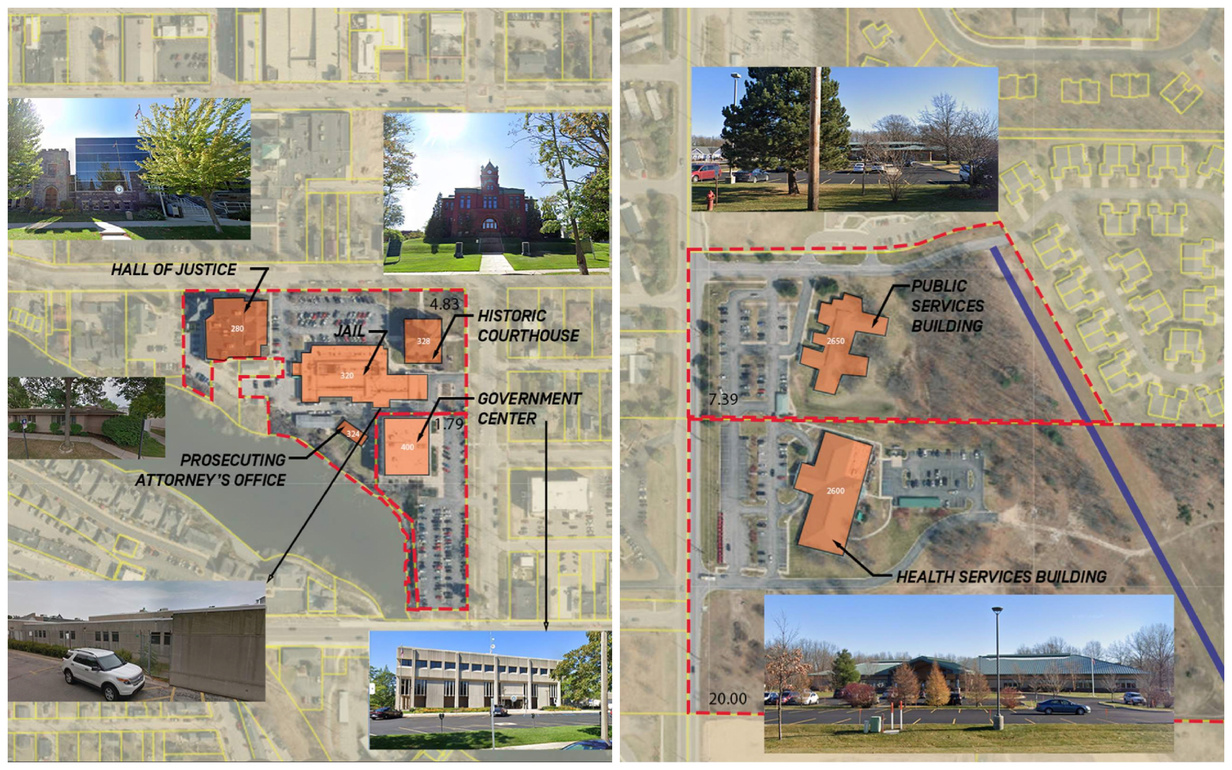
Government Buildings Well-Maintained But Need ADA, Mechanical, Envelope Upgrades
By Beth Milligan | June 23, 2023
Buildings owned by Grand Traverse County and the City of Traverse City are well-maintained but – reflecting the older age of most government facilities – are often in need of accessibility, mechanical, and building envelope upgrades.
That’s the initial takeaway from a joint facilities master plan being prepared by consulting firm Tower Pinkster, which has evaluated nearly 500,000 square feet of facilities, buildings, and courthouses owned by the county and/or city and shared early findings with county commissioners Wednesday. Tower Pinkster will create a final plan this fall that will include suggested improvements and cost estimates to modernize facilities, as well as strategic recommendations that could include building out the county’s LaFranier Road campus and/or relocating the county seat of government.
Commissioners agreed in February to hire Tower Pinkster through a request-for-proposals (RFP) at a cost of $98,750 to create the facilities master plan. Grand Traverse County owns multiple properties totaling 2,761 acres of land spread out over six different townships and the city, according to a 2019 audit. That property had a true cash value at the time of over $262 million.
In addition to vacant and recreational/park property, the county owns and operates 15 facilities and buildings, including three buildings jointly owned with the city. Those include the Governmental Center, the law enforcement center on Woodmere Avenue, and 520 West Front Street, which houses the Commission on Aging and MSU Extension (the city’s fire department is also next door). Because of that overlap, the county and city agreed to a cost-sharing arrangement to cover both county and city buildings being evaluated.
Ryan Archer, senior design architect and planner with Tower Pinkster, told commissioners his firm has assessed “just about every square foot of city and county-owned facilities,” looking at everything from parking lot conditions to building infrastructure to restrooms to accessibility. Buildings are generally well-maintained, Archer said, but often have issues with ADA (Americans with Disabilities Act) accessibility “because they’re older facilities, and this was not code-required when they were built.” Also as a result of age, infrastructure – including mechanical, electrical, and plumbing – is outdated in many buildings, as are the building envelopes (the exteriors).
Archer said Tower Pinkster is taking a “two-pronged” approach to its work. The first is to use the current condition of buildings to create a baseline and deliver a report with recommendations and cost estimates for getting each building up to at least “good” condition. The other is a strategic master plan that takes a higher-level approach in looking at the possible uses for each space and offers planning options for optimizing them. Archer said his firm has interviewed departments across the city and county to determine their needs, including what’s working well, what’s not, and what could be improved to provide better resident access to services.
Archer said those interviews highlighted some key trends. Employees identified the need for improved wayfinding and more clarity around government services, better storage, more training and conference space, and increased safety and security for staff and visitors. Staff also advocated for keeping continuity or “synergies” between county and city services. As has long been discussed, the Grand Traverse County Jail was singled out as being at capacity and past its useful life. Employees also talked about the possible reorganization of services at the Governmental Center, as well as expanding services at the county campus on LaFranier Road.
Archer said next steps will include taking that feedback to create strategic suggestions on how to best utilize each facility, then running those ideas by employees again to refine the plan. Strategic options could include some previously discussed major moves, like relocating and consolidating county services at the LaFranier Road campus. However, moving the county seat of government – that is, where elected officials like the county clerk, treasurer, prosecutor, and others are based – from one jurisdiction (like the City of Traverse City) to another (like Garfield Township) would require voter approval. Commissioner Darryl Nelson noted such a move – if recommended in the plan – would be one of many strategic recommendations and shouldn’t be focused on exclusively yet.
Commissioners also discussed the need for public engagement with the plan. Staff said the goal was to launch a community engagement campaign – the scope and cost of which is still being finalized – later this summer or early fall once a draft plan is ready. That will allow residents to review the recommendations and weigh in before the final plan is completed in November. Commissioners also noted the need to consider demographics when looking at how to best use buildings, considering the age of residents as well as those with different income levels and mobility/transportation options who might need – for example – centralized access to services. Archer said his firm would be considering all those factors, including looking at average travel times required to reach different services.
Having an updated facilities master plan will be important going forward considering that the Grand Traverse region is one of the fast-growing areas in Michigan, Archer said. Having modernized facilities optimized for both employee and resident use will allow the county and city to continue providing “services at the level everyone expects them to be provided,” he said. While Archer said trends are moving toward more digital engagement and access – like residents paying bills or requesting permits online – many people still want to access services in person. Archer said the facilities master plan will maintain that “personal access and engagement” in its recommendations, working to ensure that government buildings remain “transparent and welcoming and accessible.”
Pictured: Tower Pinkster overview of Boardman, LaFranier campuses
Comment






